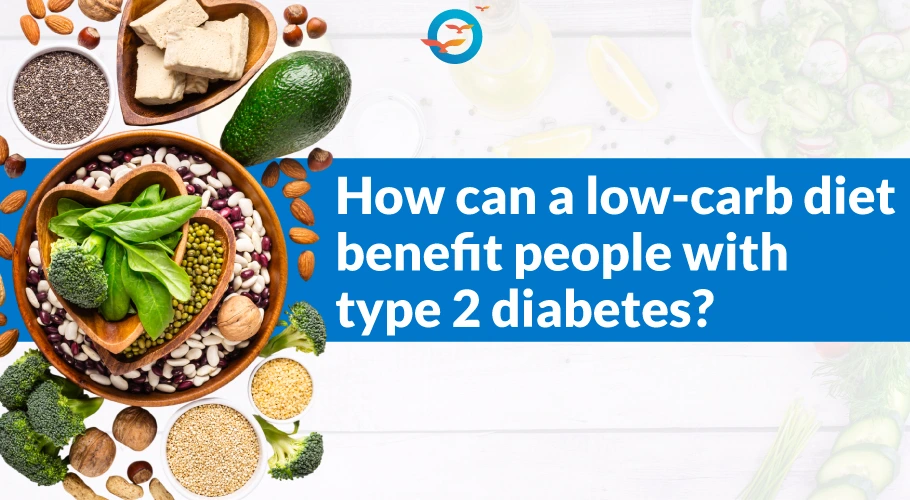How can a low-carb diet benefit people with type 2 diabetes?

Understanding High-Carb vs. Low-Carb Diets - What You Need to Know
When it comes to managing your health especially if you're living with diabetes knowing the difference between high-carb and low-carb diets is essential. Each has a distinct impact on your body and energy levels, and understanding them helps you make informed dietary choices.
What is a High-Carb Diet?
A high-carb diet involves getting 45–65% or more of your daily calories from carbohydrates. These carbs typically come from grains, rice, bread, pasta, fruits, and starchy vegetables. This type of diet is common in traditional meal patterns and is often recommended for athletes or individuals who require high energy output. However, it may not be suitable for everyone especially those with blood sugar concerns.
What is a Low-Carb Diet?
In contrast, a low-carb diet restricts carbohydrate intake to around 20–45% of daily calories, focusing more on healthy fats and proteins. This diet is especially popular among people aiming to lose weight or manage chronic conditions like type 2 diabetes and metabolic syndrome, as it helps stabilize blood sugar levels and reduce insulin spikes.
Why Blood Sugar Control Matters for Diabetics
If you have diabetes, keeping your blood sugar levels within the recommended range is absolutely critical. High sugar levels over time can damage key organs, increasing the risk of complications such as heart disease, kidney issues, vision loss, and nerve damage. On the flip side, very low sugar levels can be equally dangerous. Maintaining a stable range enhances your energy, mood, and quality of life.
Tip: Regular monitoring and the right diet can empower you to live a full, active life with diabetes.
The Downside of High-Carb Diets for Diabetics
A high-carb diet can elevate HbA1c levels in diabetics due to frequent glucose spikes after meals. Carbs, especially refined ones, break down quickly into sugar, pushing blood glucose levels higher. This leads to poor long-term control of diabetes and raises the risk of complications. Reducing carb intake, especially from processed sources, is a key strategy for better HbA1c control.
Low carb diet and type 2 diabetes
Here’s the good news: A low-carb diet helps regulate blood sugars more efficiently. By reducing carb intake, especially from high-glycemic foods, blood sugar remains more stable throughout the day. This not only supports a healthier HbA1c but also improves insulin sensitivity and may reduce your dependence on medications over time.
Result : Fewer sugar spikes, more energy, and a smoother path to diabetes reversal.
Don’t Just Go Low-Carb Go Smart with Your Choices
While cutting carbs is helpful, a balanced low-carb diet still needs to provide all essential nutrients. This means ensuring enough fiber, vitamins, protein, healthy fats, and minerals. Also, don’t forget about the glycemic index (GI) and glycemic load (GL) both play a vital role in how your blood sugar responds to food.
Choose low GI, low GL foods to maintain sugar balance without missing out on nutrition.
Expert Guidance Makes All the Difference
Every diabetic has unique needs. That's why it’s important to consult a qualified diet expert when adopting a low-carb approach. They can personalize your meal plan, ensure nutrient adequacy, and help you stay on track with long-term goals like diabetes reversal or improved metabolic health.
Final Thoughts: Why a Low-Carb Diet Works for Type 2 Diabetes
A low-carb diet offers powerful benefits for type 2 diabetes from lower HbA1c levels and reduced sugar spikes to fewer medications and greater well-being. With the right support and a focus on balanced nutrition, you can take charge of your health and create a sustainable path to long-term diabetes control or even reversal.
Ready to take control? A smart low-carb plan might just be your best ally in the journey toward better health.
FAQs
What is a low-carb diet for diabetes?
A low-carb diet for diabetes restricts carbohydrate intake to manage blood sugar levels, typically focusing on non-starchy vegetables, proteins, and healthy fats.
How does a low-carb diet help control blood sugar?
By reducing carbohydrate intake, there's less glucose entering the bloodstream, leading to lower and more stable blood sugar levels.
What foods are best on a low-carb diet for diabetes?
Non-starchy vegetables, meat, poultry, fish, eggs, cheese, nuts, seeds, and healthy fats like olive and avocado oil are good choices.
Can a low-carb diet cure diabetes?
While a low-carb diet can significantly improve blood sugar control and potentially lead to diabetes remission in some individuals, it's generally not considered a cure.
How fast can a low-carb diet lower blood sugar in diabetes?
Significant reductions in blood sugar levels can often be seen within days or weeks of starting a low-carb diet.
How many carbs should I eat if I have type 2 diabetes?
There's no one-size-fits-all answer; individual carb needs vary, but many find success with a range of 20-50 grams or up to 100-150 grams of net carbs per day, always under medical guidance.

